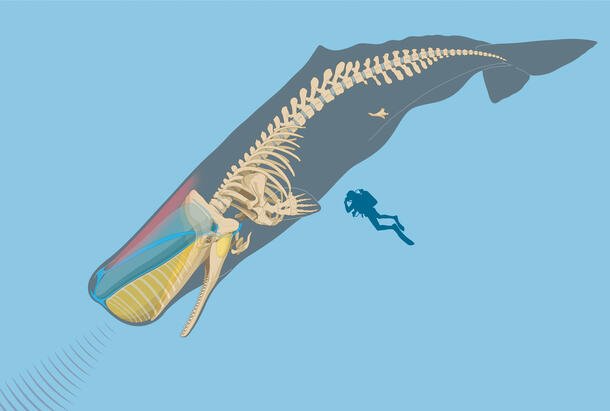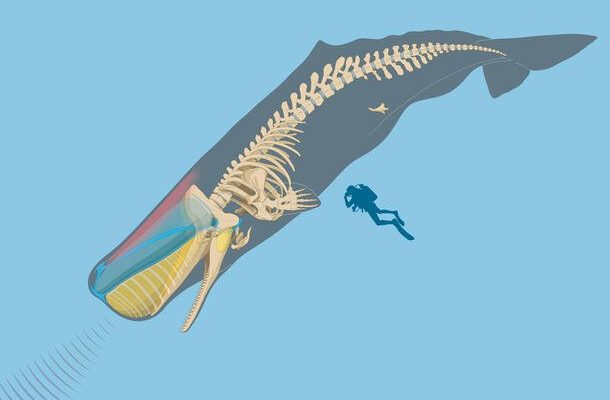
So, what exactly allows the sperm whale to be such a successful inhabitant of the ocean depths? It’s all about adaptation. From its specialized body structure to its unique hunting techniques, every aspect of the sperm whale’s biology plays a role in its survival. Let’s dive into some of these remarkable adaptations and see how they help the sperm whale thrive underwater.
Enormous Size and Streamlined Body
One of the most striking features of the sperm whale is its enormous size. Adult sperm whales can reach lengths of over 60 feet and weigh up to 45 tons. This size isn’t just impressive; it serves a crucial purpose. The large mass helps the whale maintain its body temperature in the cold depths of the ocean. Just like how a big pot retains heat longer than a small one, a larger body helps keep the whale warm.
Moreover, its streamlined shape allows sperm whales to swim efficiently. Picture a torpedo slicing through water; that’s how a sperm whale moves. With a tapered head and a sleek body, these whales can cover miles with minimal energy, which is essential for long dives where they hunt for squid and other prey.
Deep Diving Ability
Sperm whales are famous for their deep diving capabilities. They can dive to depths of over 3,000 feet and hold their breath for up to 90 minutes! Here’s the thing: while you and I might start to feel panicky underwater, sperm whales have developed adaptations to deal with high-pressure environments.
One of these adaptations is a unique lung structure. When a sperm whale dives, it can collapse its lungs, which reduces the air volume in its body and decreases buoyancy. This is similar to how some submarines expel air to dive deeper. Additionally, their blood has a high concentration of myoglobin, the protein that stores oxygen, allowing them to use their oxygen supply efficiently during long dives.
Echolocation: Nature’s Sonar
Now, you might be wondering how a creature can navigate and find food in the dark depths of the ocean. The answer lies in echolocation. Sperm whales have developed a sophisticated system that allows them to “see” their environment through sound. Imagine sending out a sound wave and listening for the echo to bounce back—that’s how they locate prey and avoid obstacles.
Using their large, spermaceti-filled heads, these whales produce clicks and whistles that travel through water. When these sounds hit an object, like a school of squid, they bounce back, giving the whale a mental image of its surroundings. This adaptation is not only crucial for hunting but also for communication with other whales in their pod.
Unique Social Structure
Sperm whales aren’t just solitary creatures; they have a strong social structure. Typically, females and their young form tight-knit pods, while adult males often roam alone or in small groups. This social behavior allows them to cooperate during hunting and to share information about good feeding areas.
For instance, while diving, a mother whale can teach her calf how to use echolocation and even demonstrate hunting techniques. This learning is vital for the calf’s survival and helps maintain the pod’s knowledge across generations. The social nature of sperm whales enriches their lives, making them not just survivors but thriving members of the ocean community.
Thick Blubber and Skin
To tackle the icy temperatures of deep-sea habitats, sperm whales are equipped with a thick layer of blubber. This layer acts as insulation, much like a warm coat in winter, keeping them cozy in frigid waters. Additionally, their skin is tough and thick, which protects them from potential injuries caused by other marine life or harsh conditions.
Interestingly, the blubber also serves as an energy reserve. During times when food is scarce, sperm whales can rely on this fat to sustain them. It’s a great survival strategy, ensuring that they can last longer during lean periods without risking their health.
Regenerative Teeth
When you think of teeth, you might picture something meant for chewing, but for sperm whales, it’s a different story. Instead of using their teeth for eating, sperm whales primarily have teeth that help them capture prey. In fact, males can have up to 26 conical teeth in their lower jaw!
These teeth are designed for gripping slippery squid, which are their primary food source. Interestingly, sperm whales have the ability to regrow lost teeth, which not only helps maintain their hunting efficiency but also keeps their mouths in good shape as they age. This regenerative capacity adds another layer to their impressive survival toolkit.
In summary, sperm whales are truly fascinating creatures, equipped with an array of adaptations that allow them to thrive in the underwater world. Their enormous size, remarkable diving ability, advanced echolocation, strong social structures, protective blubber, and unique teeth all play significant roles in their survival.
Understanding these adaptations not only enriches our appreciation of sperm whales but also underscores the importance of protecting their habitats. By learning more about these underwater giants, we can contribute to their conservation and ensure that future generations can marvel at their magnificence. So, the next time you think of a sperm whale, remember that it’s not just a big fish; it’s a marvel of evolution that has mastered the depths of our oceans.

